The Orchid family (Orchidaceae) with 25,000 to 30, 000 different species that exist, are the largest family of plants in the entire world.
Orchid species vary considerably in appearance, whether in size, weight, color or shape. Although they are part of a huge family, many orchids are critically endangered and can be rarely seen in the wild.
Among this large variety, there is a surprising number of orchid species that have such a strange appearance that it is almost unbelievable to conceive of them as typical flowers. Indeed, Mother Nature can totally astound you with her creativity! From Flying duck orchid to Swaddled baby orchid or Angel orchid and without forgetting the Naked man orchid, even these names would make you raise an eyebrow and the photos might just make your jaw drop in amazement.
Scroll down to see these fascinating orchid species and read about them.
1. Dracula simia (Monkey orchid)
The Dracula simia, also known as Monkey orchid, is native to tropical highland forests of southeastern Ecuador and Peru, thriving at an elevation of 3,000 – 6,000 feet. The name Dracula simia actually translates to “little dragon monkey”, which is an allusion to the mythical Count Dracula, and it is attributed to this genus due to the blood-red color of several of the species and the unusual aspect of the long spurs of the sepals. This species has its arrangement of column, petals and lip that strongly alludes to a monkey’s face.
The plant blooms at any season, with several flowers on the inflorescence opening successively and emitting the scent of ripe oranges. The orchid genus Dracula consists of 118 species and some of the most sought-after species are the D. vampira, D. chimaera, D. bella, D. gorgona and D. simia, whether it’s due to their interesting flowers or to their peculiar names.
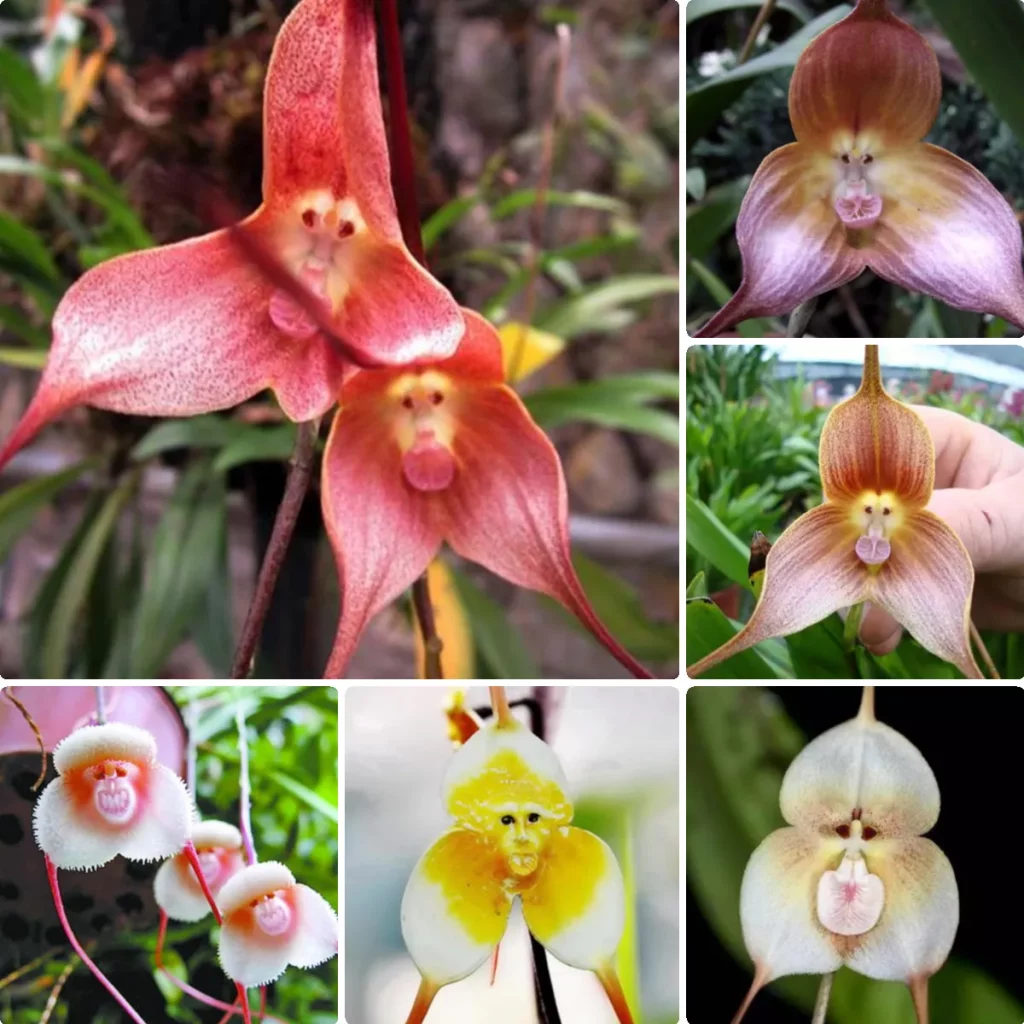

Credit: Steve Beckendorf
2. Lepanthes nycteris
Lepanthes nycteris, a species of orchids found in the cloud forest of Cochabamba State, Bolivia and in Peru at elevations around 1750 m. In some angles, it may appear like a small person sitting on a throne, with the legs dangling off the edge. The flowers are mostly small, measuring a little over 2 cm tall, but very unusual, intricate and often very colorful. The plant has oval leaves on thin, wiry stems and the flowers come in succession on thin dangling spikes.
Lepanthes (from Greek “scaled-flower”) is a large genus of orchids with about 800–1000 species occurring in the Antilles and from Mexico through Bolivia, with very few species found in Brazil. While some flowers can be several centimeters in size, others are often only a few millimeters.

Credit: Terra Galleria Photography
3. Paphiopedilum (Lady’s slipper orchid)
Paphiopedilum, commonly referred to as the “lady’s slipper” or “slipper orchids” is a genus of the subfamily Cypripedioideae of the flowering plant family Orchidaceae. Lady’s slipper orchids have various species and hybrids occurring in a vast range of color combinations.
Members of this genus attract a number of orchid collectors due to the intriguing and unusual form of their flowers. The distinctive pouch-like labellum of the flower traps insects seeking nectar. To leave again, the insects have to climb up past the staminode, behind which they collect or deposit pollinia. The Paphiopedilum genus is native to Southeast Asia, the Indian Subcontinent, southern China, New Guinea and the Solomon and Bismarck Islands.

Credit: Mary Haber
4. Calochilus campestris (Copper Beard orchid)
The Calochilus campestris, commonly known as the Copper Beard orchid, is a species of orchid indigenous to south-eastern Australia. It is a terrestrial, perennial, deciduous, herb with an underground tuber and a single, fleshy erect basal leaf 15 –35 cm long, 1 – 1.5 cm wide that is three-cornered in cross-section. The flowering stem bears between three and fifteen pale green flowers with reddish lines, 1.8 – 2.2 cm long and 1.2 – 1.6 cm wide.
The base of the labellum is fleshy, with the labellum covered in coarse, purple hairs which are reminiscent of a long, dishevelled beard – hence the common name beard orchid. The short column often has spots that resemble eyes (called “sham eyes”) but without a ridge joining them.

Credit: James Peake
5. Caleana major (Flying duck orchid)
Caleana major, commonly known as the Large duck orchid or the Flying duck orchid, is a small orchid found in eastern and southern Australia. The resemblance to a duck in flight of this exceptional flower is indeed uncanny. The flower attracts insects such as male sawflies, which pollinate the flower in a process known as pseudocopulation.
Caleana major is a tuberous, perennial herb, usually growing to a height of 20 – 40 cm (8 – 20 in) with a single reddish, narrow lance-shaped leaf, often spotted, emerging at its base. The labellum, which resembles the head of a duck, is held above the flower by a sensitive strap-like stalk. When touched, the labellum turns rapidly downward, trapping a visiting insect between the labellum and column wings.

Credit: Heinrich Cuno / Flickr
6. Habenaria radiata (White egret flower)
Habenaria radiata (also called Pecteilis radiata), commonly known as the White egret flower, Fringed orchid, Crane orchid or Sagisō, is a species of orchid native to China, Japan, Korea and Russia and grows naturally in grassy wetlands, upland bogs and seepage slopes. This orchid is named for its exquisite flowers, which have a striking resemblance to an elegant Great white egret in flight.
The pristine white flowers measure 1.5 in (4 cm) wide, feature two large, extremely fringed petals that spread laterally, from which a central elongated and pointing petal extends. The way the petals splay upwards really accentuates the similarity with wings, with the white plumage puffed out, giving the flower an almost angelic look. There are up to 7 grass-like leaves, each measuring between 5 and 20 cm (2 and 8 in) long and about 1 cm (0.5 in) wide. The white egret orchid flower’s stalk holds from 1 to 8 flowers, each being around 4 cm wide. This species is in rapid decline in the wild, due to over collection and habitat destruction.

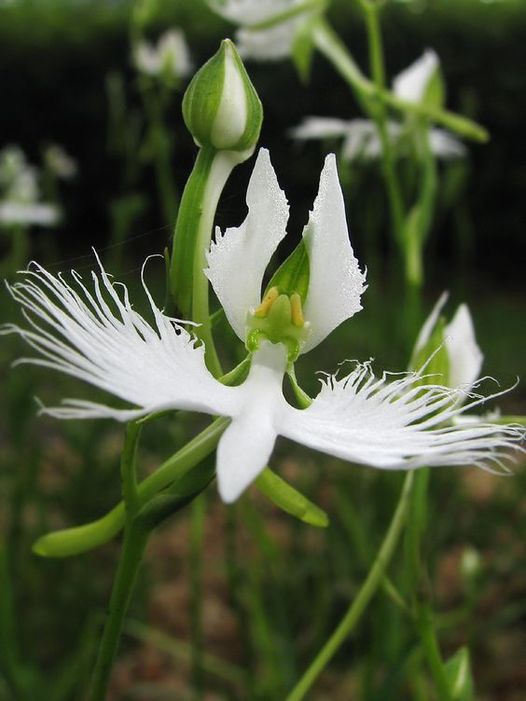
Credit: ashitaka-f / Flickr
7. Epidendrum coriifolium
Epidendrum coriifolium is a sympodial orchid which grows at altitudes of 1400 – 1700 m in dense forests in Brazil, Ecuador, Mexico, Central America, and Venezuela. When viewed at the right angle, these flowers very much seem like cute, spooked out faces. The compressed stems grow between 12 – 25 cm long, with 2 – 8 distichous, rigid and concave leaves of green color with purple shades at the base, measuring 8 – 25 cm long and 1 – 3 cm wide.
The inflorescence is terminal, bearing 4 -10 flowers opening in succession, of waxy consistency and varying in colors – cream to green to purple-brown or mahogany, often showing purple nerves on the sepals and brownish blushes around the margins of the green lip. The flowers smell at night, but are known to be rather unpleasant.

Credit: Nurelias / Flickr
8. Miltonia clowesii
Miltonia clowesii, also called Clowes’ miltonia, is a species of orchid of the genus Miltonia, endemic to southeastern Brazil, found at elevations of around 800 m. This species somehow shares some resemblance with a starfish.
The slender, erect or arching inflorescence, reaching about 60 cm long, has 7 to 10 successively opening flowers. The flowers measuring 5 – 8 cm in diameter and since they open successively, the plant is able to flower for a long period of time. The widely spread petals have a pointed end and are yellow in color, with nut-brown horizontal lines and spots. The long, sharp tip of the violin-shaped lip is white on the upper half and purple on the other half, where it is additionally decorated with 5-7 convex lines.
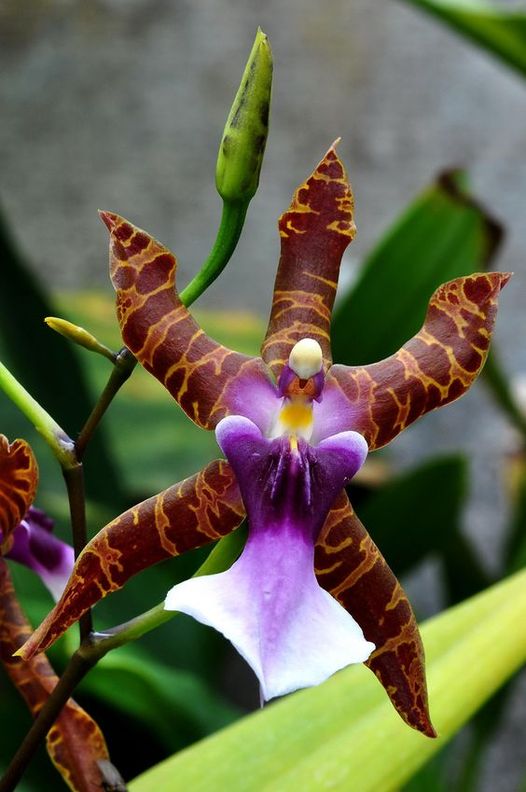
Credit: Nurelias / Flickr
9. Anguloa uniflora (Swaddled baby Orchid)
Anguloa uniflora, commonly known as Swaddled baby orchid and Tulip orchid, is found on the floor of the forests in high elevations in the Andes regions around Peru, Colombia, Venezuela and Ecuador. The genus consists of nine distinct species and four natural hybrids. The ‘Swaddled baby’ name refers to the appearance of this intricate flower that resembles a baby swathed in cozy blankets. Its other common name, Tulip orchid, alludes to its similitude with a tulip flower. The exterior of the flower has petals arranged in an overlapping manner before it opens fully, similar to the petals of tulips.
The plant grows up to a height ranging from 18 to 24 in. Underneath the slender and pleated leaves are the pseudobulbs which are conical in shape. These exceptional flowers are unusually large in comparison to the size of the plant and the petals are waxy, cream-colored or completely white. They are also extremely fragrant, like a cinnamon scent. Anguloa uniflora usually bloom during spring season, and the blooms are long lasting and perform best in low light locations.
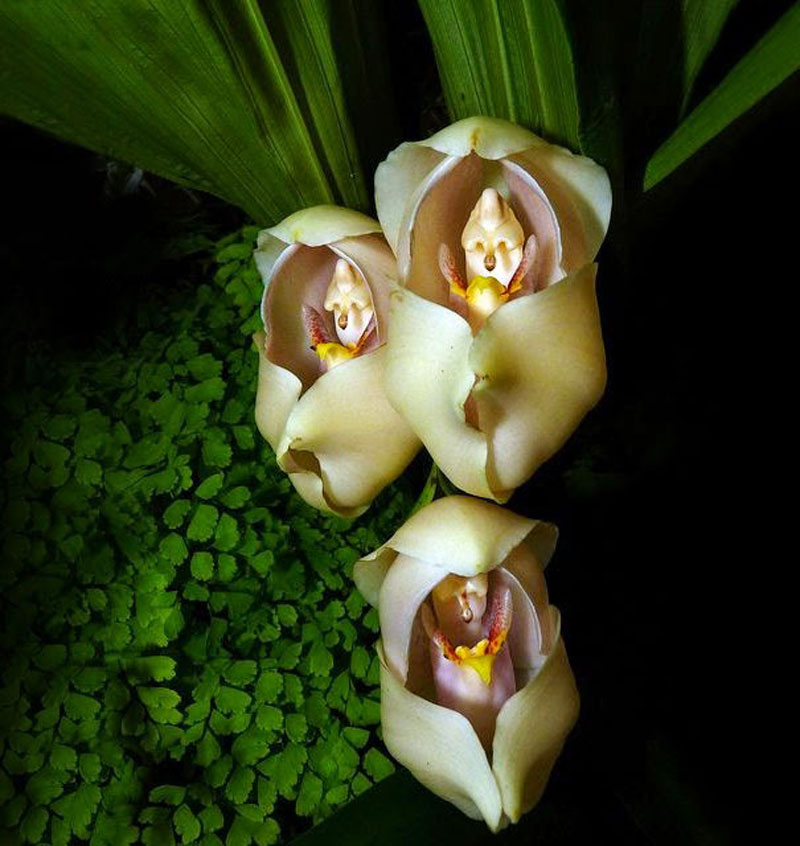
10. Ophrys bombyliflora (Bumblebee orchid)
Ophrys bombyliflora, known by its common name Bumblebee orchid, is a species of Ophrys (bee orchid), native from the Mediterranean region from Portugal and the Canary Islands to Turkey and Lebanon. The genus name Ophrys is of Greek origin and means ‘eyebrow’, referring to the hairy fringe of the lips of the flower of many orchids in this genus. The specific epithet bombyliflora is from the Greek word bombylios which means bumblebee and alludes to the appearance of the flowers of this species.
The flowers have distinct and quite large oval green sepals and small, triangular petals, sometimes bearing a bronze color tinge. Ophrys bombyliflora is pollinated by males of solitary bees (Genus Eucera which are not bumblebees). Similar to other species of Ophrys, the flowers imitate the females in appearance and scent. While trying to mate with the flowers (“pseudocopulation”), earlier-emerging males collect pollinia in the process, which they transfer to other flowers of the same species.
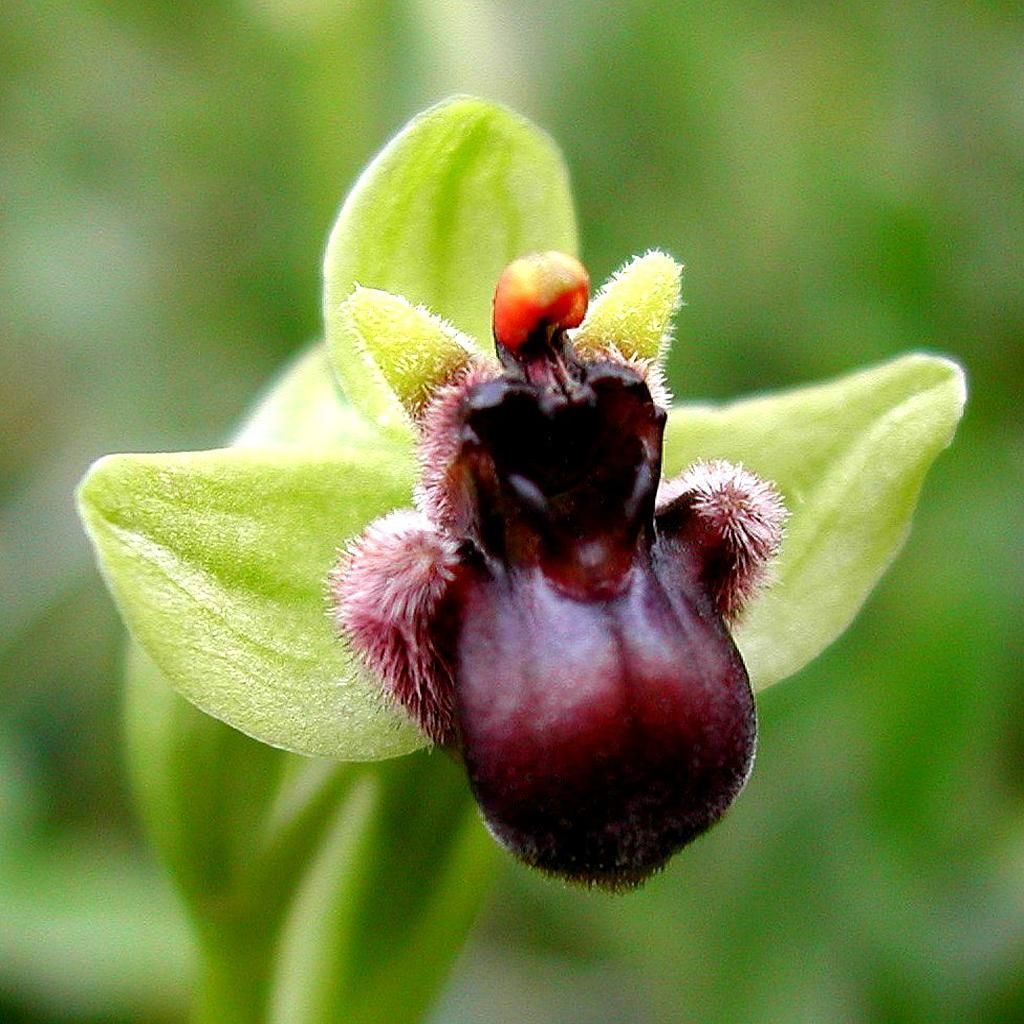
11. Orchis italica (Naked man orchid)
Orchis italica, also commonly named the Naked man orchid or the Italian orchid, is a species of orchid native to the Mediterranean region, more precisely to southwestern and southeastern Europe, western Asia, and northern Africa. Its common name “Naked man orchid” is in reference to the lobed lip (labellum) of each flower which mimics the general shape of a naked man.
This species prefers partial shade and grows well in low nutrient soil, and blooms in April. It reaches 50 cm (20 in) in height, with bright pink, densely clustered flowers and has a rosette of leaves with distinct undulating edges at the base of the plant. Additionally, the stem is enveloped in 3 or 4 small leaves. The flowers are borne in a dense inflorescence and are normally pale to dark pink but occasionally white specimens can occur, although they are rare.

Credit: Luis nunes alberto via Wikimedia Commons
12. Habenaria grandifloriformis (Angel orchid)
Habenaria grandifloriformis, commonly called the Angel orchid, is an exquisite orchid species from the open high altitude grasslands of southern India. It is distinguished by its gorgeous, white bilobed petals which has the appearance of an angel floating around, wrapped in a white mantle.
The Angel orchid is a terrestrial herb and can have one or more flowering stems but usually no more than five per plant. The stems grow up to 12 cm high and yield one flower at the end of each stem. During the growing season, this species usually produces just a single, heart shaped and rounded leaf which lies flat on the ground. The blooms emerge from June to July, at the beginning of the monsoon season.
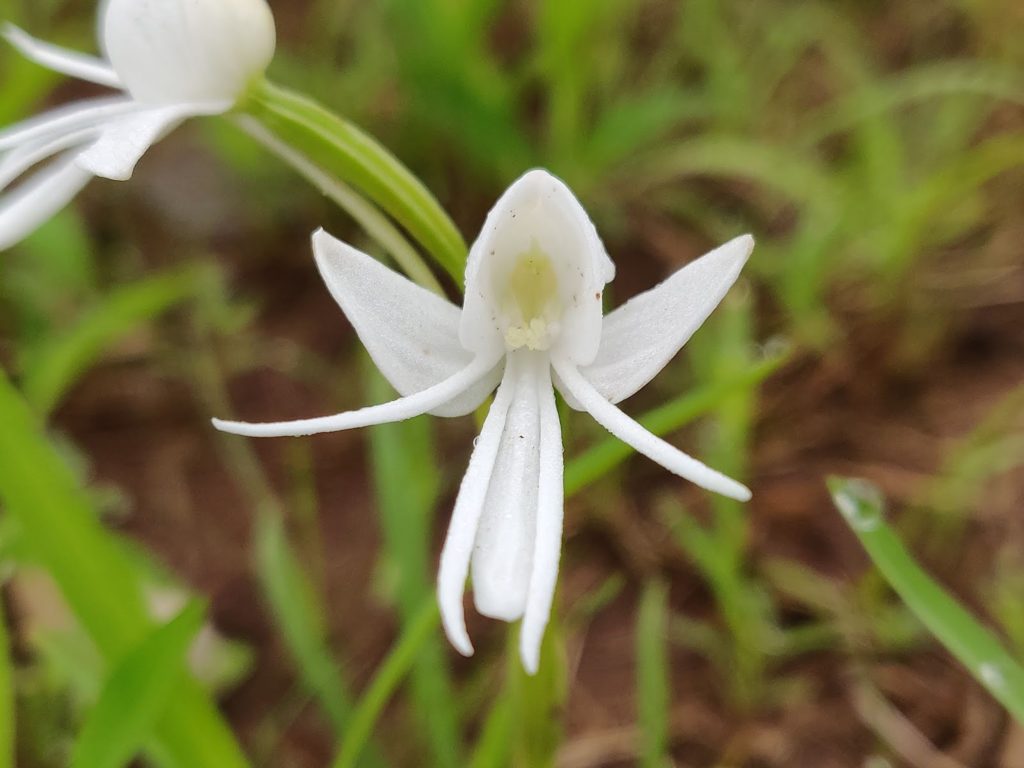
Credit: blog.natureweb.net
13. Prosthechea cochleata (Clamshell orchid)
Prosthechea cochleata, commonly referred to as the Clamshell orchid, is distributed in the West Indies, Mexico, Central America, northern South America and southern Florida. This peculiar orchid with fragrant, clam-shaped flowers has yellowish-green, ribbon-like petals that hang down like curly tentacles, which explains their other given name, the Octopus orchid.
The flowers are unusual in that, though the labellum is usually below the column in the orchids, Prosthechea species have the labellum in a “hood” shape over the column. The labellum faces upward and not downward like in most species of orchids, thus resulting in the flower being upside down, or non-resupinate. The uppermost part of the lip is broadly cordate and concave, purple to brown in color with veins radiating from the base. Prosthechea cochleata blooms on a sequential inflorescence with one bloom after the other fades, and seems to always be in bloom.
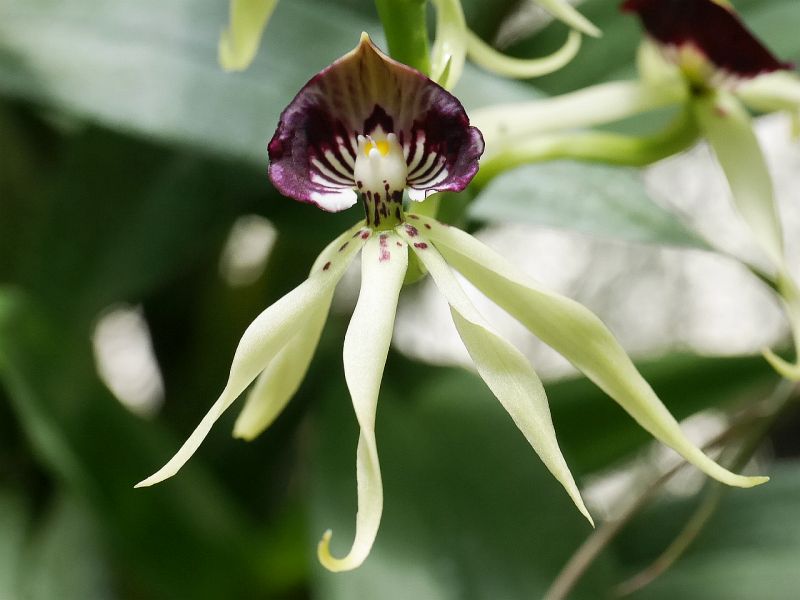
Credit: Petr Kocna
14. Peristeria elata (Dove orchid)
Peristeria elata is a beautiful epiphytic and terrestrial orchid native to the Central American countries of Panama, Ecuador, and Venezuela. It is commonly referred to as the Dove orchid, Holy Ghost orchid, Holy Trinity orchid or even Flower of the Holy Spirit. These common names are due to the shape of a well-defined small white dove visible in the central part of the flower.
The oval-shaped, elongated pseudobulbs are about 5 in long, with 4 to 5 large leaves (up to 1 meter long) emerging from the apex of the pseudobulbs. The inflorescence can reach a height of 4 feet and bears 4 to 12 waxy, fragrant blooms of striking marble white color with purple spots, and yellow-colored anther and pistil. Flowers bloom the most in late summer and early autumn, although spikes can take months to reach maturity. The flowers are long-lasting, with four to six flowers being open at a time.
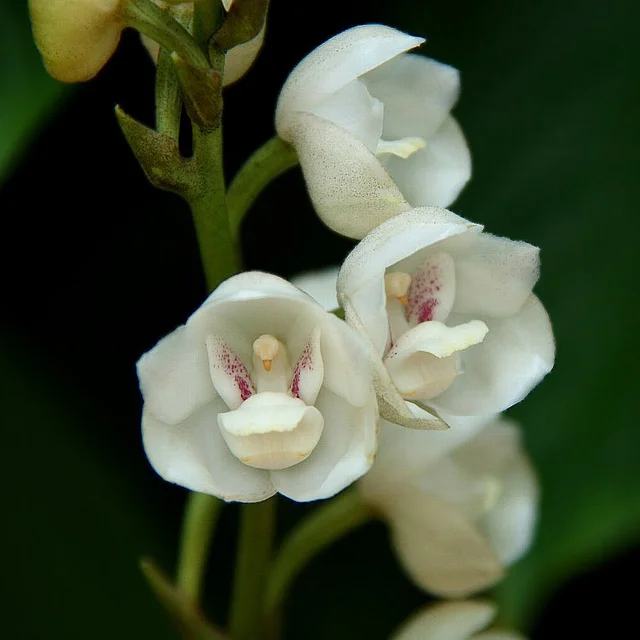

Src: illuzone.net








